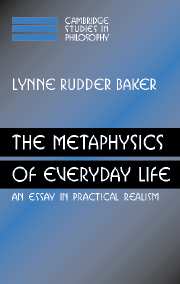11 - Five ontological issues
Published online by Cambridge University Press: 22 September 2009
Summary
The familiar things that we interact with daily have ontological significance in their own right: they are not really something else. Persons, microscopes, cats, and all the other inhabitants in the everyday world are of real kinds whose appearance in the world makes an ontological difference: “Person,” for example, is not just a phase-sortal like “child”; nor does it designate a property or abstract entity; nor does it refer to a logical construction of nonpersonal elements. Similarly for other familiar objects: something that is a microscope could not have existed without being a microscope. Ordinary objects are nonredundant, in that they cannot be omitted from ontology without rendering ontology deficient. An inventory of what exists is incomplete if it leaves out persons, screwdrivers, houses, cats, or the other kinds of things that we routinely interact with. (Or so I have argued for the past ten chapters.) In this chapter, I want to discuss five of the ontological issues in the background of this view of ordinary things: Ontological Significance, Time and Existence, Ontological Novelty, Ontological Levels, and Emergence.
AN ACCOUNT OF ONTOLOGICAL SIGNIFICANCE
I have said several times that ordinary things have ontological significance. How should we understand what ontological significance is? Intuitively, to say that Fs (tigers, chairs, anything) have ontological significance is to say that the addition of a (nonderivative)1 F is not just a change in something that already exists, but the coming-into-being of a new thing.
- Type
- Chapter
- Information
- The Metaphysics of Everyday LifeAn Essay in Practical Realism, pp. 218 - 240Publisher: Cambridge University PressPrint publication year: 2007

